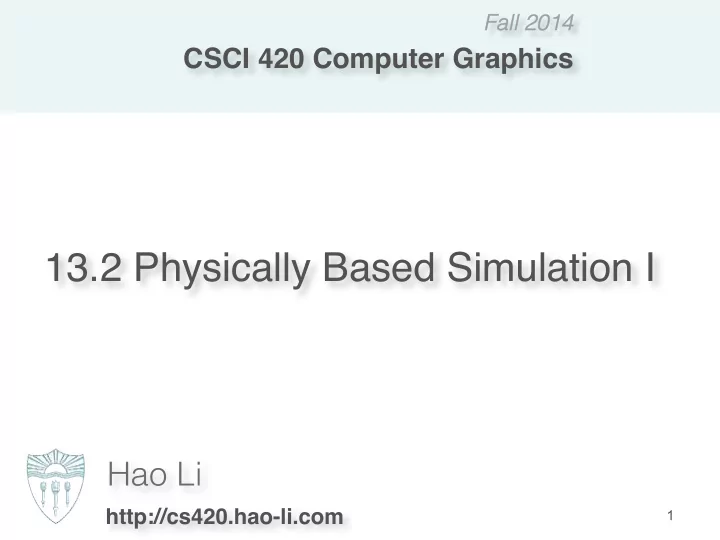

Fall 2014 ! Fall 2014 CSCI 420 Computer Graphics � � � � � 13.2 Physically Based Simulation I � � � � � � Hao Li http://cs420.hao-li.com 1
Visual Computing 2
Animation 3
Animation Techniques 4
Physics in Computer Graphics • Very common • Computer Animation, Modeling (computational mechanics) • Rendering (computational optics) 5
Physics in Computer Animation • Fluids • Smoke • Deformable strands (rods) • Cloth • Solid 3D deformable objects .... and many more! 6
Physical Simulation 7
Scientific Goals and Challenges 8
Offline Physics • Special effects (film, commercials) � • Large models: millions of particles / tetrahedra / triangles � • Use computationally expensive rendering (global illumination) � • Impressive results � • Many seconds of computation time per frame 9
Real-time Physics • Interactive systems: computer games virtual medicine (surgical simulation) � • Must be fast (30 fps, preferably 60 fps for games) Only a small fraction of CPU time devoted to physics! • Has to be stable, regardless of user input 10
Examples 11
Fluids Enright, Marschner, Fedkiw, SIGGRAPH 2002 12
Fluids and Rigid Bodies 13
Fluids with Deformable Solid [Robinson-Mosher, Shinar, Gretarsson, Su, Fedkiw, SIGGRAPH 2008] 14
Deformations [Barbic and James, SIGGRAPH 2005] 15
Cloth Source: ACM SIGGRAPH 16
Cloth (Robustness) [Bridson, Fedkiw, Anderson, ACM SIGGRAPH 2002 17
Multibody Dynamics + Self-collision Detection 18 [Barbic and James, SIGGRAPH 2010]
Surgical Simulation [James and Pai, 19 SIGGRAPH 2002]
Multibody Dynamics 20
Physics in Games [Parker and James, Symposium on Computer Animation 2009] 21
Sound Simulation (Acoustics) [James, Barbic, Pai, SIGGRAPH 2006] 22
Techniques 23
Particle System 24
Particle System 25
Mass-Spring Systems 26
Applications 27
Rigid Body Simulation 28
Challenges 29
Applications 30
Grid-Based Methods 31
Example: Fluid Surface 32
FEM Simulation 33
Case Study: Mass-spring • Mass particles Source:Matthias Mueller, SIGGRAPH 34
Newton’s Laws • Newton’s 2nd law: ! ! F m a = • Gives acceleration, given the force and mass • Newton’s 3rd law: If object A exerts a force F on object B, then object B is at the same time exerting force -F on A. ! ! F − F 35
Single spring • Obeys the Hook’s law : F = k (x - x 0 ) • x 0 = rest length • k = spring elasticity ( stiffness ) • For x<x 0 , spring wants to extend • For x>x 0 , spring wants to contract 36
Hook’s law in 3D • Assume A and B two mass points connected with a spring. • Let L be the vector pointing from B to A • Let R be the spring rest length • Then, the elastic force exerted on A is: ! ! ! L ! (| | ) F k L R = − − Hook | | L 37
Damping • Springs are not completely elastic • They absorb some of the energy and tend to decrease the velocity of the mass points attached to them • Damping force depends on the velocity: � ! ! � F k v = − d � � � • k d = damping coefficient • k d different than k Hook !! 38
A network of springs • Every mass point connected to some other points by springs • Springs exert forces on mass points – Hook’s force – Damping force • Other forces – External force field • Gravity • Electrical or magnetic force field – Collision force 39
Network organization is • For stability, must organize the network of springs in some clever way Basic network Stable network Network out of control 40
Time Integration Physics equation: x’ = f(x,t) � x=x(t) is particle trajectory Source:Andy Witkin, SIGGRAPH 41
Euler Integration x(t + Δ t) = x(t) + Δ t f(x(t)) Simple, but inaccurate. � Unstable with large timesteps. Source:Andy Witkin, SIGGRAPH 42
Inaccuracies with explicit “Blow-up” Gain energy Source:Andy Witkin, SIGGRAPH 43
Midpoint Method Improves stability � 1. Compute Euler step Δ x = Δ t f(x, t) 2. Evaluate f at the midpoint f mid = f((x+ Δ x)/2, (t+ Δ t)/2) � 3. Take a step using the midpoint value x(t+ Δ t) = x(t) + Δ t f mid Source:Andy Witkin, SIGGRAPH 44
Many more methods • Runge-Kutta (4th order and higher orders) � • Implicit methods – sometimes unconditionally stable – very popular (e.g., cloth simulations) – a lot of damping with large timesteps � • Symplectic methods – exactly preserve energy, angular momentum and/or other physical quantities – Symplectic Euler 45
Cloth Simulation • Cloth Forces � - Stretch � - Shear � - Bend � • Many methods are a more advanced version of a mass-spring system • Derivatives of Forces [Baraff and Witkin, – necessary for stability SIGGRAPH 1998] 46
Challenges • Complex Formulas � • Large Matrices � • Stability � [Govindaraju et al. 2005] • Collapsing triangles � • Self-collision detection 47
Self-collisions: definition Deformable model is self-colliding iff � there exist non-neighboring intersecting triangles. 48
Bounding volume hierarchies [Hubbard 1995] [Gottschalk et al. 1996] [van den Bergen 1997] [Bridson et al. 2002] [Teschner et al. 2002] AABBs AABBs [Govindaraju et al. 2005] Level 1 Level 3 49
Bounding volume hierarchy root root 50
Bounding volume hierarchy v w v w 51
Real-time cloth simulation Source: Andy Pierce % Forces + Model Triangles FPS % Solver Stiffness Matrix Curtain 2400 25 67 33 52
http://cs420.hao-li.com Thanks! 53
Recommend
More recommend